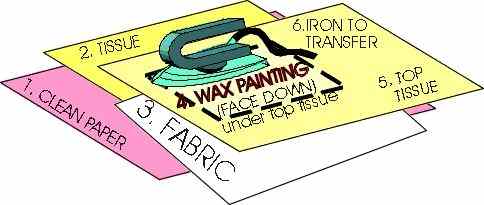




 |
 |
 |
 |
 |
DEVELOPMENT |
ONLINE
PROJECTS |
|||||
Some Fabric Techniques for Encaustic ArtImages on wax coated cards can easily be transferred onto fabric. In a nutshell you just turn the card face down where the image is to be printed on the fabric and iron over the back of the card. The wax re-melts and is absorbed into the fabric, creating a reverse print of the original image. This simple process opens up all sorts of possibilities but do remember that it is best suited to "non-contact" applications. That means washing the printed fabrics is not advised. If you really want to, then use natural fibres which will retain a reasonable version of the printed wax image. Tee shirt material is actually quite good. If the wax is not washed out then the colours could soften through heat and smudge other adjacent material (eg clothes!). Take a look at these embroidery examples and get a more detailed step by step list for the wax transfer / printing on to fabric techniques, down the page. Silk applications are mentioned at the bottom of this page - to be updated in the future. |
 |
The Wax transfer technique
|
|
SILK will give the best wax prints, but do make sure to put extra tissue underneath the fabric during the printing transfer process. This is necessary to absorb the excess wax. For silk it is almost as though the images "passes through" the material. Once the wax image is on the silk you might experiment by stretching the fabric on a frame and over-washing with silk colour. The wax acts as a semi-resist and wonderful effects can be achieved. We'll illustrate this sometime in the future. |
|